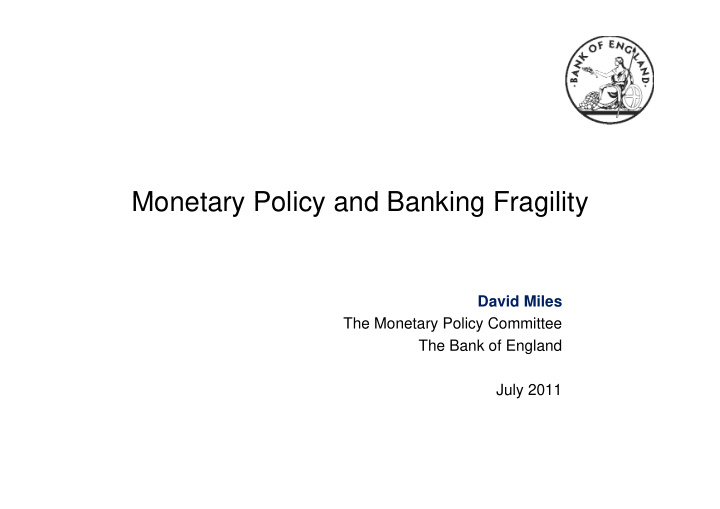



Monetar Polic and Banking Fragilit Monetary Policy and Banking Fragility David Miles The Monetary Policy Committee The Bank of England July 2011
Level of output relative to pre-crisis trend during past recessions (a) past recessions (a) Yearsfrom start of the recession Yearsfrom start of the recession 100 Index bas 1 2 3 4 5 6 7 98 ed in year of p 96 94 94 peak level of 2008 1990 92 1979 output 1929 90 1973 88 (a) I use GDP and trend growth estimates from Hills, Thomas and Dimsdale ( Bank of England Quarterly Bulletin 2010) to create this chart. The authors use a Hodrick-Prescott filter to separate the trend and the cyclical components of real GDP growth. I assume that their trend growth estimate at the start of each recession would have prevailed during the following seven years had the recession not occurred The chart shows deviations of actual GDP from this projected trend growth seven years had the recession not occurred. The chart shows deviations of actual GDP from this projected trend growth. The dotted line for the latest recession uses the MPC’s mean projection for output growth over the forecast horizon as reported in the May 2011 Inflation report. 2
Projection of the level of GDP Source: ONS and Bank calculations Source: ONS and Bank calculations 3
4 Households’ response to higher inflation expectations expectations
5 Private sector pay settlements
6 Major UK banks’ and LCFIs’ leverage ratios
Contributions to the change in major UK banks’ core Tier 1 capital ratios core Tier 1 capital ratios 7
Approximate ownership structure of major UK banks’ liabilities banks liabilities Liability instrument Li bilit i t t C Counterparty t t % of total liabilities % f t t l li biliti Deposits Banks 14% Private non-financial corporations 5% Households 16% Other financial corporations 18% (OFCs) Bonds and medium-term notes largely banks, OFCs largely banks OFCs 8% 8% in issue Other debt securities in issue likely to be banks, OFCs 6% Subordinated liabilities largely OFCs 2% Oth Other liabilities (includes li biliti (i l d N/A 26% derivatives) Total equity largely OFCs 5% ...of which Core Tier 1 equity q y 4% Source: Bank calculations. Breakdown of liabilities at the end of 2010 for Alliance and Leicester, Barclays, Bank of Ireland, Cooperative Financial Services, HSBC Holdings, Lloyds TSB, National Australia Bank, Nationwide, Northern Rock, RBS, and Santander. An exception are deposit holdings of private non ‐ financial corporations, households, and other financial corporations where the shares refer to all UK resident banks and other financial corporations, where the shares refer to all UK resident banks. 8
Major UK banks’ shares – investor distribution by type type Pension Fund Bank Unclassified Corporation (ERISA) 4% 11% Hedge Fund 1% 3% Manager Other 0% 1% 1% Holding Company Mutual Fund Government 0% Manager 18% 2% Individual 1% Insurance Insurance Investment Company Advisor 2% 57% Source: Bloomberg shareholders’ register Source: Bloomberg, shareholders register 9
Major US and German banks’ shares – investor distribution by type distribution by type US bank shares US bank shares German bank shares German bank shares Hedge Fund Individual Insurance Hedge Fund Government Bank Manager 1% Company Manager 3% 1% Corporation 7% 2% 0.4% 6% Government 6% Mutual Fund Bank 9% Manager Individual 1% 0% Pension Fund Pension Fund I Insurance 2% Company 1% Mutual Fund Unclassified Manager Investment Investment 2% 8% Ad i Advisor Advisor 67% 81% Pension Fund 1% Other Unclassified 1% 1% 1% Source: Bloomberg, shareholders’ register Source: Bloomberg, shareholders’ register 10
Equity-for-debt swap Original positions Original positions Now swap 5 of debt for equity Now swap 5 of debt for equity... Bank Bank Assets Funding Assets Funding A D A D – 5 E E + 5 Portfolio of the equity investor Portfolio of the equity investor Value of equity Value of equity A A - D D Value of equity Value of equity A A – (D – 5) (D 5) Value of bonds d Value of bonds d – 5 A – (D – 5) + d – 5 Total value Total value A – D + d A – D + d Total value Total value = A – D + d Note: D is total bank debt; d is the equity investor holding of bank debt Note: D is total bank debt; d is the equity investor holding of bank debt. 11
Asset mix in UCITS funds – European countries Turkey Slovakia Romania Czech Republic Italy Portugal Australia Liechtenstein Liechtenstein France Switzerland Spain Hungary Greece Luxemburg Luxemburg EUROPEAN AVERAGE Poland Finland Bulgaria Denmark Germany Germany Norway Belgium Slovenia UK Sweden Equity Fixed Income Balanced Money Market Others Source: EFAMA, ‘ Asset management in the UK: The IMA Annual Survey 2009/10’ 12
Issuance of debt instruments by major UK banks in 2010 – investor distribution by type 2010 investor distribution by type Senior unsecured issuance Covered bond issuance Govt Other agency g y Other 10% 10% G Govt t Pension 1% 7% Banks agency funds Banks 27% 6% 6% Pension 27% funds 3% 3% Insurers 13% Insurers 12% Asset managers managers Asset Asset 45% managers 43% Source: Bank calculations based on deal sheets S B k l l ti b d d l h t Source: Bank calculations based on deal sheets from debt capital market desks and Euroweek. from debt capital market desks and Euroweek. 13 Based on sample of around £25bn of new Based on sample of around £17bn deals in 2010. issuance in 2010.
Issuance of debt instruments by major UK banks in 2010 – investor distribution by type 2010 investor distribution by type Subordinated debt issuance Hedge Other Banks Funds 9% 10% Pension 3% funds 1% 1% Insurers 17% Asset sset managers 60% Source: Bank calculations based on deal sheets Source: Bank calculations based on deal sheets from debt capital market desks and Euroweek. Based on sample of around £17bn deals in 2010. 14
Recommend
More recommend